
Status Report #4
29 August 2003
This is a brief report outlining some of the activities that were undertaken at the CSIRO's Parkes Telescope in preparation for the upcoming Mars Tracks, for the week commencing 25 August, 2003.
Click here to see the preliminary schedule for the first of the Mars test tracks commencing on 8 September, 2003. Track Schedule.
Click here to see the work that was performed in upgrading the dish surface in March 2003. Surface Upgrade.
Click here to see Status Report #3.
Click on images to see the full-size versions
On Tuesday, 26 August, a teleconference was organised between Parkes and Tidbinbilla to discuss the format of the predicts and their mode of delivery to the Parkes Observatory. Present were Mike Kesteven, Graham Baines and John Sarkissian at Parkes, with Len Ricardo at Tidbinbilla.
In the previous week, a larger, compressed nitrogen gas bottle was installed on the Mars receiver to reduce the frequency of replenishment. The bottle assembly is seen here mounted on the side of the receiver. On Tuesday, 26 August, Graham Moorey, Russell Bolton, David Catlin and Brett Dawson replaced the previously installed, plastic retaining ring around the feedhorn, with a new metal retaining ring. This was to prevent the nitrogen gas from escaping and depressurising the feed, and hence preventing moisture from condensating in the feed assembly.
 |
On Wednesday, 27 August, George Graves and Alex Dunning ensured that the 5, 10 and 100 MHz reference levels from the backend rack to the JPL rack were at the appropriate levels. They had to change numerous amplifiers and other components in the backend rack modules to achieve this.
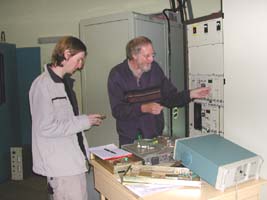 |
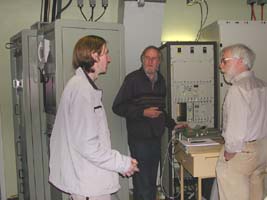 |
Also on 27 August, Graham Moorey, Russell Bolton, David Catlin, Brett Dawson, Lewis Ball, and Graham Baines performed hot/cold load tests on the Mars receiver to determine it's operating characteristics. First up was a hot load test, with David Catlin placing the absorber under the feedhorn.
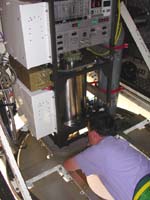 |
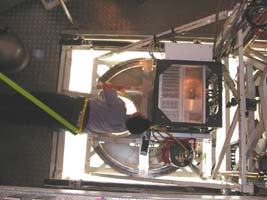 |
Brett Dawson and Graham Moorey are seen pouring the liquid nitrogen onto the absorber in preparation for a cold load test.
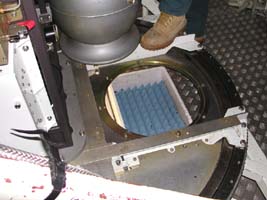 |
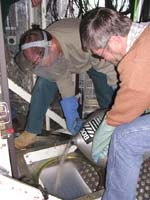 |
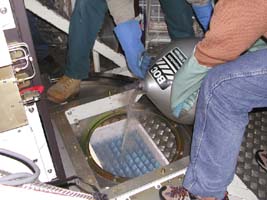 |
Graham Moorey pushed the cold absorber under the feedhorn, then confirmed with Mike Kesteven and George Graves in the control room below, that they were seeing an appropriate change in the measured noise power.
 |
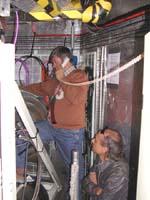 |
Following the cold load test another hot load test was performed with Russell Bolton this time placing the hot absorber under the feed horn. Graham Baines from Tidbinbilla was present to observe and participate in the tests.
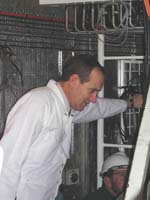 |
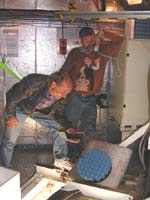 |
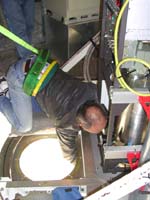 |
Later, the results were analysed in the control room and the tests were repeated again the next day, 28 August, this time with power meter measurements performed in situ by Graham Moorey, Alex Dunning and Brett Dawson. Russell Bolton and David Catlin were also involved. Simultaneously George Graves, Graham Baines and Mike Kesteven performed measurements in the control room. The new results were consistent and confirmed that the receiver was performing better than the contractual specs. A more detailed final report on the receiver's operating characteristics is being prepared. The preliminary measurements indicate:
| Tsys = 25 +/- 1 K |
| Trx = 13 K |
| Contribution from Sky and Antenna approx. 13 K |
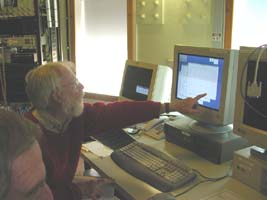 |
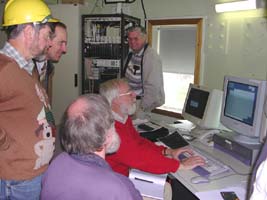 |
Also, on the morning of 28 August, beginning at 2:00 am, Mike Kesteven continued testing the new drive software.
Meanwhile, on August 27, Ewen Hopkins and John Johnson from Tidbinbilla arrived to test the operational voice lines, and for John to familiarise himself with the layout of the equipment, because he may need to troubleshoot the configuration during the ACP. Ewen and John also completed the labeling of the cables in the rack.
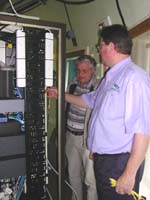 |
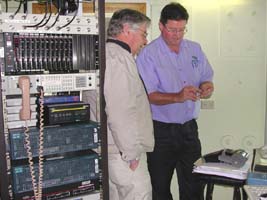 |
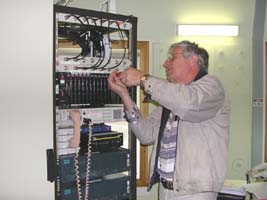 |
 |
Following dinner later that evening, on 27 August at 7:51 pm (AEST) Mars made it's closest approach to Earth since 56,617 BC. At that time Mars was 55.758 million kilometres from Earth. John Sarkissian's small, 8-inch "optical" telescope was set up, and the guys had a look at Mars. A drawing was made of Mars and compared with a CCD image of the planet taken at approximately the same time by noted Australian amateur astronomer, Peter Ward.
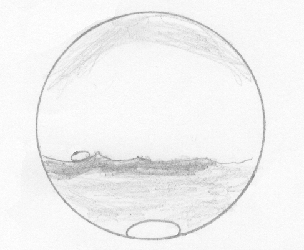 |
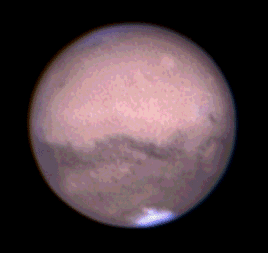 |